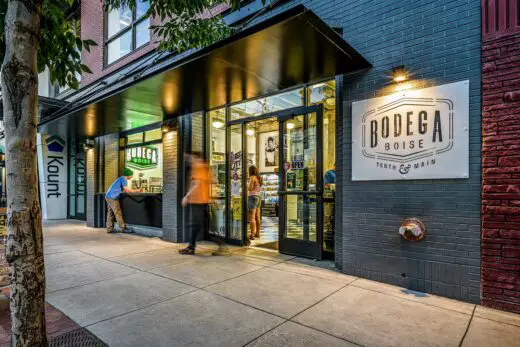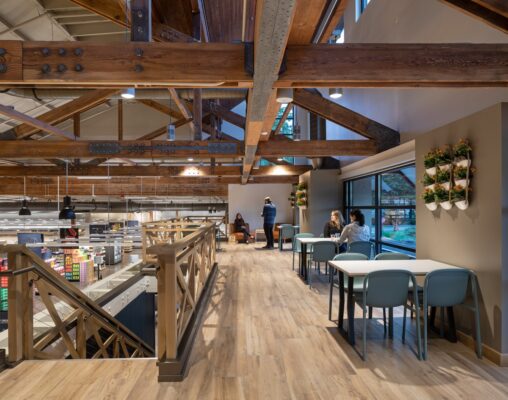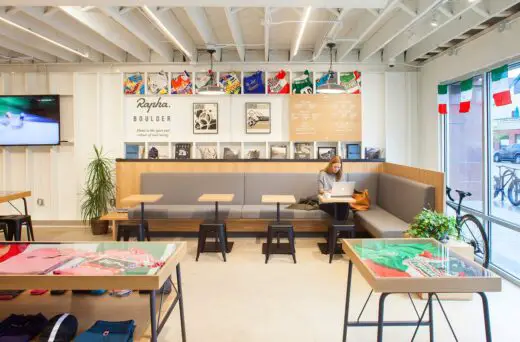The fluid, sustainable future of retail, USA Shop User Experience, Ecofeminism, Intersectionality, Building Refurbishment
The Fluid, Sustainable Future of Retail
May 12, 2022
The Fluid, Sustainable Future of Retail Article
co-authored by Sheri Blattel and Amanda Herzberg of Cushing Terrell with Rebekah Matheny of The Ohio State University
In collaboration with Associate Professor Rebekah Matheny from the Ohio State University Department of Design, Cushing Terrell’s Retail Design studio has engaged in a research project to better understand how ecofeminism and intersectionality will affect the future of retail design in the built environment.
Below are insights gained through secondary research study and observed industry trends and practice:
The Fluid, Sustainable Future of Retail Insights
To plan for the future of retail, we must consider what is meaningful to the current youth generations, which includes younger Millennials, Gen Z, and Gen Alpha. As the stakeholders of the planet’s future, these demographics value environmental conservation, truth, social justice, equity, and freedom of self-expression, and they champion sustainable consumption. They’re also gaining more spending power and greater influence all the time.
For Millennials, purchasing products that align with their values allows them a pathway to express themselves nonverbally. Gen Z cares deeply about a company’s values and purpose, wanting to know and connect with the mission behind the corporation (Ordun, 2015). They expect transparency and look for opportunities to connect with other people who value progressive ideas. They view consumption as a matter of ethical, social, and sustainable concern; thus, they place transparency, authenticity, and a higher purpose at the top of their list for retailers (Francis, T. and Hoefel, F. , 2018). This raises the question: What’s the relationship between youth generations, sustainability, and equity — and how will that influence the future of retail?
Expectation and Action
Younger generations have an increased interest in sustainability, along with a greater likelihood to hold others accountable. Their motivations often turn to advocacy and action that are grounded in equity and social justice.
When we think of leaders in the sustainability movement, Greta Thunberg comes to mind. What started as an individual act, her Fridays for Futures protests have become a global movement leading to climate marches that invite all generations and nationalities to participate. Not only is she a youth climate activist, but she’s also a female change-maker who has risen as a compelling ecofeminist voice, paving the way for other intersectional eco-activists. She advocates for equal access to a healthy planet no matter one’s socioeconomic status or place of origin. It’s just one example of youth generations’ expression of values and the way they intersect economically and ecologically — and also illustrates why this intersectionality should be weighed heavily in discussions about rethinking retail — each purchase will be weighed against a bigger moral picture.
The rise of younger generations as activists over the last decade shows an increased awareness of values translating into eco-conscious action. Powerful conversations and rapid societal change have led to a shift in behaviors and consumer expectations as modern societal norms are being redefined. We can look to the history of ecofeminism and forward to find the ways in which gender identity and gender fluidity factor into the sustainable consumer movement, and how these ideals could become significant influencers of younger generations’ role in the future of retail.
Ecofeminism and Beyond
Ecofeminism is a philosophical and political movement that combines ecological and feminist concerns. Author Françoise d’Eaubonne coined the term in 1974, basing it on the fundamental feminist tenets of equality between genders, a revaluing of non-patriarchal or nonlinear structures, and a view of the world that respects organic processes, holistic connections, and the merits of collaboration. The movement set out to address the domination of women and the dilapidation of the environment as consequences of patriarchy and capitalism.
While women consumers have led in this arena, the dismantling of gender norms is helping sustainable consumption grow in popularity across the gender spectrum. Historically, women tend to be more open to learning new ways to be sustainable and are statistically silent leaders in sustainable consumption — particularly as it relates to shopping habits as defined by gender role stereotypes. Studies have shown women are more likely to make sustainable purchases linked to aspects of living: cleaning products and groceries, for example, or the re-use of products and materials (Bloodhard and Swim, 2020). On the flip side, another study showed men are less likely to participate in sustainable practices and consumption because they don’t want to have a feminine connotation attached to them.
But as younger generations begin to dismantle gender norms, they’re more likely to embrace sustainable practices regardless of biological sex. Research suggests that sustainable consumption is not based on the biological identity of a person but based on the gender with which they identify (Bloodhard and Swim, 2020). Gen Z, more so than older generations, tends toward gender neutrality and gender inclusivity. To them, sexual identity is a spectrum; they’re sometimes referred to as “identity nomads.” As gender norms defined by society fall to the wayside, younger consumers seek to shift societal perceptions through their self-expression, behaviors, and fashion.
The collective tendency to maintain some amount of ambiguity socially is something designers should both learn from and can leverage. Royce Epstein, curator of Dissent by Design, which explores design’s role in social movements, says:
“There have been additional views within ecofeminism that call for an end to binary oppositions since they reinforce oppression and exploitation. We know that culture is so much more diverse than any binary groupings, so feminists argue that women shouldn’t all be grouped together as that doesn’t take into account race — such as BIPOC — or class divides. Today, ecofeminism calls for an end to all of this and instead embraces nature and culture as equals with inclusion, compassion, and a more holistic view on how to solve the problems of the climate crisis along with how we view and treat women, people who identify as women, and all marginalized people.”
Retail’s Role on Behavior Changes
This raises the notion that eco-behaviors may not be a result of one’s genetic sex but are developed through a socialization process. And as retail plays a major role in society and socialization, there’s an opportunity — maybe even an obligation — to aid in forming these eco-conscious behaviors.
Social movements of the past few years have provided retail an opportunity to reset and rethink. Shopping is more than a purchase, it’s a means of self-expression and self-realization, the ability to make choices to express one’s true self. Brands must break stylistic gendered stereotypes of how men and women shop by creating space for expression and a sense of freedom to explore and identify freely with choices. The navigation within physical space is fundamentally built on trust and comfort.
This can be achieved by avoiding binary choices and disconnecting gender implications in finish material, color, and branding selections. Store designs can allow space for honest representation of the consumer and not a generated perception of what a brand thinks the consumer should be based on a heteronormative mindset. Brands need to reflect diversity, equity, inclusion, and sustainability commitments in recognition of the conscious consumer in their marketing and across physical brick and mortar, virtual, and social spaces.
As we more fully explore the social and gender tendencies of the emerging generations, it’s important to note the distinction between the terms unisex and genderless. Unisex as a reference serves to accommodate both masculine and feminine by finding a middle ground without any specific gender in mind, whereas the terms genderless and gender fluid step out of the gender binary to include LGBTQIA+ community. Making these distinctions is important as the intersectionality between conscious consumption and gender fluidity is evolving, providing an opportunity for brands to be more inclusive of a broadening range of identities.
Levi’s, an evolutionary and longstanding retailer dating back to 1853, is at the forefront of recognizing this intersectionality. The brand’s Buy Better/Wear Longer campaign not only tapped a younger generation of influencers, but also underscored Levi’s values and efforts that appeal to this demographic. The campaign featured young changemakers and activists who identify across the gender spectrum, including actor Jaden Smith, YouTuber Emma Chamberlain, footballer Marcus Rashford, and hip-hop artist Xiuhtezcatl — all of whom advocate for the value of slow fashion. Levi’s call to action is to embrace individuality and self-expression while championing sustainability, sparking greater cultural awareness with intersectional influence. Backed by recognizable influencers, the campaign becomes both approachable and trusted, opening the doors for discourse.
Many other brands and activists, such as Pattie Gonia, a drag queen and activist who promotes environmental conservation, are joining the effort to break down gender stereotypes. Pattie’s Instagram depicts this new vision: a drag queen in high-heel boots, wig, and gown (made from a reclaimed tent), climbing a mountain and cleaning up a beach. Pattie is reclaiming the gendered outdoorsman/eco-identity and the products that support it. It presents a new audience and thus a wider outdoor retail segment, which REI has embraced by supporting the development of Pattie’s documentary, “Dear Mother Earth.”
How will Intersectionality Influence the Future of Retail?
Intersectionality is the acknowledgement of the potential for any individual to experience discrimination and oppression — or privilege — based on their unique experiences or situations. With this acknowledgment comes the potential to create inclusive versions of movements — whether social or environmental — that advocate for the protection of people and the planet in mindful and equitable ways. The intersection of feminism and sustainability is one example. But for today’s youth, the environmental movement needs to become even more inclusive, where sustainability, gender fluidity, black, indigenous, and people of color (BIPOC) are at the center of environmental activism and experiences.
As brands embrace the significance of eco-consciousness, intersectionality, and widening expressions of identity, what subsequent considerations should designers and retailers embrace? Youth consumers seek spaces for self-expression in which their experience is developed through a sense of freedom to explore and identify freely with their choices. Immersive and memorable experiences occur in environments that are welcoming and affirming and allow for an inclusive invitation to build a personal relationship with the brand.
Thoughtful design interpretation of these shared values can translate a brand’s purpose-driven ideology into purposeful, sustainable physical retail experiences. Physical space — in conjunction with brand storytelling and authentic messaging — will result in built environments that attract young consumers. Details matter: Fitting room design, product categorization, responsible materials sourcing, consideration of embodied carbon, imagery, model selection, and in-store brand ambassadors are key considerations when designing inclusive retail environments. Designing these spaces optimally is truly about maximizing the experience per square foot, ensuring that in every moment, at every touchpoint, the principles of design intersect with the principles of the consumer.
Rapid societal change is being expressed through evolving consumer needs and expectations and a shift in societal norms. The voice of the generation of young changemakers is critical in developing solutions to address unsustainable, morally questionable practices and behaviors. With this knowledge, retailers have an opportunity to re-imagine the consumer experience with a renewed understanding of their customer base and an acknowledgement of the bigger societal picture.
While the shift in design considerations toward embracing inclusivity and promoting equality has begun to transform retail spaces and experiences, there’s still much ground to cover. This is a powerful conversation we’re dedicated to understanding more fully and incorporating into our retail practice at Cushing Terrell. As we engage in further discussions on this topic, we look to these younger generations to motivate and inform our ongoing research and design practice.
References
Bloodhart, B. and Swim, J. (2020). Journal of Social Issues, Vol. 76, No. 1, 2020, pp. 101-113
Francis, T. and Hoefel, F. (2018).True Gen: Generation Z and Its Implications for Companies. McKinsey & Company.
Ordun, G. (2015) Millennial (Gen Y) Consumer Behavior, Their Shopping Preferences And Perceptual Maps Associated With Brand Loyalty. Canadian Social Science, Vol. 11, No. 4, 2015, pp. 40-55. ISSN 1712-8056
The fluid, sustainable future of retail information / images received 120522
A recent architectural article by Cushing Terrell on e-architect:
April 1, 2022
Data-Informed Design for User Experience at Work
by Sandi Rudy, RID, LEED ID+C and Jennifer Moore, NCIDQ
Throughout the pandemic and currently, building owners and clients have been more inclined to utilize smart building features, which help bring transparency to building performance and wellness metrics:
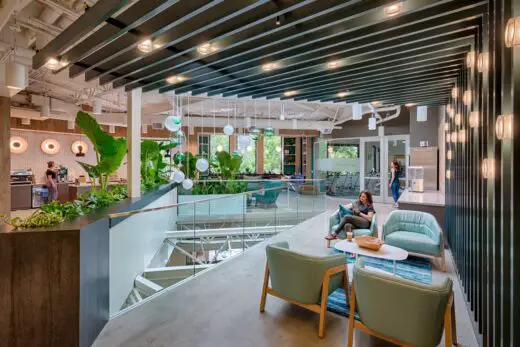
photo : Marco Zecchin
Data-Informed Design for User Experience at Work
Comments on this article by Cushing Terrell are welcome.
Cushing Terrell
Cushing Terrell ATX Office
Architecture: Cushing Terrell
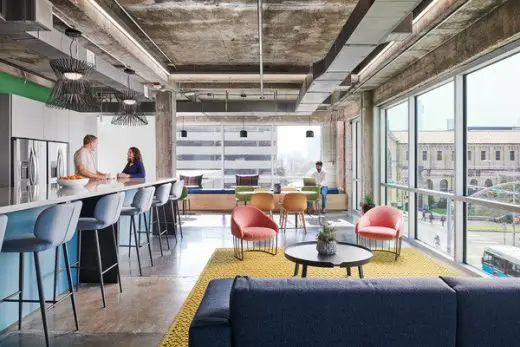
photograph : Peter Molick
Cushing Terrell ATX Office in Austin, Texas
Location: Austin, Texas, USA
Architecture in Texas
A US building design by Cushing Terrell Architects on e-architect:
Stockman Bank Missoula Downtown, Montana
Contemporary Texan Buildings
Design: Miró Rivera Architects

photograph : Paul Finkel, Piston Design
Residence 1446 in Austin
Design: Bercy Chen Studio, Architects
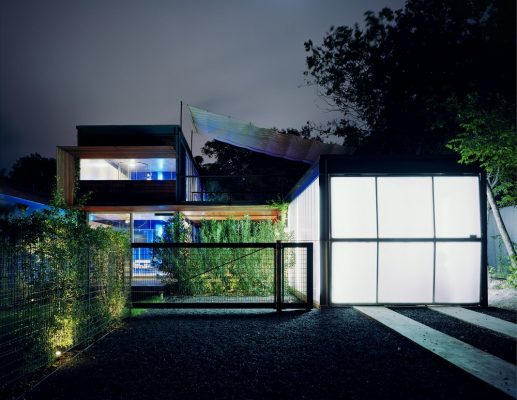
photo from architects
Annie Residence in Austin

image from architect
Buddy Holly Hall of Performing Arts and Sciences in Texas
American Architecture Design – chronological list
Observation Tower at Circuit of the Americas Texas
Contemporary Rollingwood House, Travis County
Design: Bade Stageberg Cox, Architects

image from Chicago Athenaeum
Comments / photos for the The fluid, sustainable future of retail architectural article by Sheri Blattel and Amanda Herzberg of Cushing Terrell with Rebekah Matheny of The Ohio State University page welcome




